A Short Essay About Gaucho Knives: Facón,
Daga, Cuchilla and Puñal
The
different knives used by gauchos,
and some interesting coincidences and a common root between puñales
and Bowie knives.
by Abel A. Domenech
We generically term the different
types of edged weapons used by gauchos in the past as
cuchillos criollos (creole knives). We employ this generic
name as the gauchos didn't use just one class of knife,
but would employ different ones depending upon their personal
tastes, customs, or what they could find or acquire.
About
the Gauchos
The gaucho was a specific
human type: a free man, always changing of settlement, with no
personal land, few personal belongings and no boundaries. An
excellent rider, hunter of wild cattle, with no employer and
no fixed job, he preferred to be an errant rider crossing the
silent and deserted big plains. Gauchos appeared as a
result of the crossing of the blood of the Spanish with the local
Indians and it is generally believed that the gaucho first
appeared in those territories of what today is the Republica
de Uruguay, on the North bank of River Plate opposite from where
Buenos Aires is situated. Gauchos quickly spread across
the River into territories of what today is known as Argentina.
All those territories were then known as Virreynato del Rio de
la Plata and were under the control of the Crown of Spain. There
was no division into the present countries of Argentina and Uruguay
in those remote times (XVII to beginnings of XIX centuries).
Both the gauchos of Uruguay and of Argentina have very
similar characteristics in customs and clothing. A somewhat different
type of gaucho also developed later in the southern region
of what today is Brazil, in the Rio Grande do Sul zone. What
we can call a 'gaucho type' went under several different names
during the XVII century, being called changadores, arrimados,
amiluchos, gauderios, etc. before being called
gauchos for the first time, probably by the end of the
XVIII century.
In those early times, these gauchos
of the River Plate area had encounters with gangs coming from
neighboring territories in dispute with Spain and under control
of the Portuguese Crown (presently the southern territories of
Brazil), who crossed the frontiers while smuggling, committing
robberies, etc. Of course, those encounters were very far from
being friendly ones! The gangs of tough Portuguese speaking men
were astonished to see the long bladed knives used by the Spanish
speaking gauchos, which were too short to be called swords
and too long to be called simply as knives. Therefore, they called
them "big knife;" "knife" in Portuguese is
faca, and the noun for "big knife" is facao,
which is pronounced approximately as facáun. When
Spanish speaking gauchos heard that funny way of calling their
big knives, they liked it, and adopted the phonetic in Spanish
language, as facón.
It has to be explained that the
first Spaniards' settlements around the coasts of the River Plate
were made around the 1530s and subsequent to their initial failure,
many of the few horses and cows brought from Spain gained liberty
and escaped to the great open plains which offered these animals
ideal conditions of grass, water and mild weather. These initial
small herds gave rise with the passing of the following 150 years
to the huge herds of thousands and thousands of cimarron
(wild) cattle (both horses and cows) which astonished the voyagers
who arrived in these lands in the following centuries after the
first foundations of Buenos Aires.
These huge herds gave origin to
a large local industry based upon the chasing and hunting of
wild cattle just to take their hides for export to Spain, which
required the special permission of the Cabildo Institution, which
represented the King of Spain in our lands. These expeditions
required many men working as hunters, killers and skinners and
also soldiers to protect against Indian attack. Of course, many
entrepreneurs found that more profitable business could be made
organizing their own non authorized expeditions to get the cattle
and smuggle the hides to other markets in Europe.
Gauchos
were men of the frontier and recognized no Law, no King, no Patron
and they committed robberies and other felonies and, as such,
were pursued by the Law. Their services as knowledgeable men
of the plains were required from time to time by owners of big
rodeos of cattle or by the chiefs of the expeditions organized
by the Cabildo to hunt wild cows and get their skins. This helped
to put an end to the pursuit by the Law, at least during the
course of those authorized expeditions. But
then, they also hunted wild cattle for themselves, without the
required Cabildo permission, and smuggled the skins for their
own profit or were employed by the organizers of the non authorized
expeditions. Later, in several
stages of our history, they were forced to form part of the regular
Army and, badly armed and badly equipped, were employed in the
Independence and Civil wars and during the war against the Indians,
under orders of military brass, politicos or civilian leaders.
These human types known as camiluchos,
gauderios and those other names given before that of gauchos
all had similar characteristic behaviors, remaining in constant
change, adaptation and modification of their clothes, tools,
and riding apparel according to times and personal possibilities.
Everything was capable of being used, changed, adapted, modified
to their personal tastes or customs. That's why it's so difficult
to classify the edged weapons they employed and also their other
pieces of tackle and riding equipment. To study an object it
is first necessary to arrive at a classification method and to
then use a more or less methodic description to allow observation
and classification of a particular specimen as such or such variant.
We should always have in our minds, though, what we said before
regarding the personality of gauchos and their ability
to adapt or modify their equipment, including riding tackle and
weapons. This is especially important with their knives, because
we will always find pieces which fail to fit exactly within the
characteristics we hereby show, or to fit well into any of the
types named here, though it should be possible to classify most
into one of the four basic types we propose.
Real gauchos disappeared
by around the 1880/1890s with the arrival of wire fences, the
telegraph and the railroad. They adapted, becoming employees
under the directions of the owners of estancias, or otherwise
they just vanished. Today, the
public image of the gaucho is very different from its
true former sense; a new, positive image has replaced the bad
one the gaucho had in centuries past. The gaucho
is now an icon who represents Argentineans, in a similar sense
as cowboys represent Americans. Far from his true origins, the
gaucho is known today for his riding skills, his knowledge
of cattle and the secrets of countryside work, his personal valor
and his generosity; everything forming an image coined by a romantic
sense imparted by literature and with the forgiveness of the
passage of time.
The
Gaucho´s Arms and Tools
Gauchos
were simple poor people; skilled riders and handlers of cattle,
they had and required very little equipment. Among the gaucho's
tools and weapons were the lazo (lariat) and bolas
(a throwing weapon inherited from the Indians). The hobbles were
another humble, but important, tool which, used to tie together
the front legs of the gaucho's horse, prevented the loss
of the horse out in the middle of the great lonely plains. A
gaucho without horse, in the middle of those great plains,
was a dead man. Then, of course, there was the knife, an edged
weapon and a multipurpose tool used almost at any time during
the gaucho's day. Gauchos had limited access to
firearms, which in our territories were reserved to the high
or military classes almost exclusively. For this same reason,
gauchos seemed to look upon firearms with disdain and
little confidence, preferring edged weapons over all other types.
Several types of knives were used
by gauchos in the past. They received different names
depending on shape, general design and local customs. It is worth
noting that, being persons of little literacy, gauchos
called their knives by different names, paying little attention
to their true characteristics but using the names they would
have heard from their elders. Thus, a knife was a facón
for one person, but the same knife may have been called a daga
by another. It is also worth noting that the features which must
be present in a specific specimen in order to classify it as
a particular type are subject to debate, as there is no definite
or rigid pattern or list of characteristics which exactly define
each one. The present classification,
which I propose in my books and writings, is that classification
that I have used during the last 25 years and can be considered
of rather "modern" usage, though based in the local
customs and the most widely accepted morphology of each variant.
Some authors accept these definitions as offered while others
propose some little changes. When considering gaucho knives,
we must always bear in mind that their manufacture was more a
result of improvisation in taking advantage of the available
materials, than a true cutlery product, as with the English cutlery
trade.
As a matter of fact, the local "cutlery
industry" was very simple: Silversmiths took blades imported
from Europe and provided rich handles and occasionally sheaths.
Simple blacksmiths made entire simple knives with whichever metal
was at hand. Old or broken swords, sabers or bayonets donated
their blades to make facones or dagas.
Types
of Gaucho Knives
Basically, we can establish four
main types: facón, daga, cuchilla
and puñal. The facón and daga
were fighting weapons while the cuchilla and the puñal
were multipurpose tools, although the skill of gauchos
in handling a long bladed knife for small or delicate cutting
tasks would also have allowed them to use their long facones
as a common knife if needed. Each of these knives have subtypes
depending on subtle design differences, size or regional manufacture,
however, such analysis is out of the scope of this article.
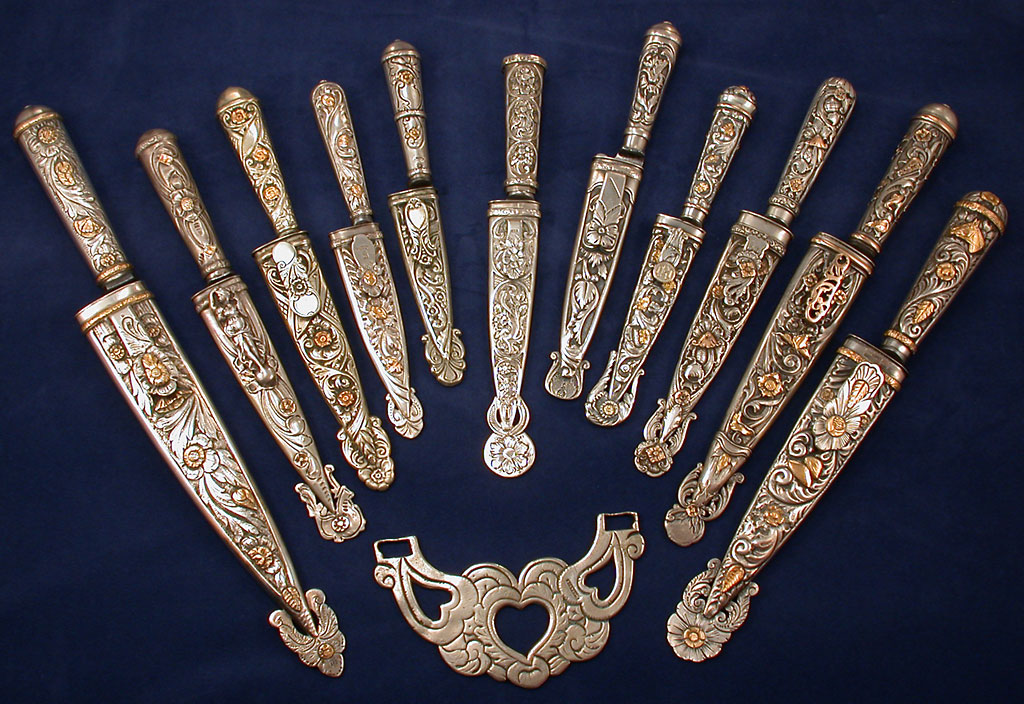 |
Photo
1. A group of puñales and verijeros. The
difference in name relates to the length of the blade which,
in turn, conditioned the place of carrying.
Verijeros usually have a blade of 13 to 15 cm (around
7 to 8 inches), while puñales had blades of 10
to 14 inches length.
The knives in this picture have handles and sheaths made of silver,
some with decorations in gold. |
The luxurious silver and gold embellished
knives made their first appearances after the 1830/1840s, once
the true local silversmith trade was established. In those early
years, this type of costly knife was destined mainly for wealthy
estancieros (ranch and land owners), high ranking military
or rich politicos, and not for ordinary gauchos,
who were usually very poor and the owners of very few personal
belongings, as previously said. However, the taste for flashy
silver ornamented knives, horse headstalls and saddles quickly
spread among gauchos and Indians, defining their most
prized possessions and serving as symbols of power and rank.
So, while both of these human types were usually very, very poor
they tried by all means (including trade and robbery) to get
some silver into their belongings.
Common knives were handled with local woods, cow horns or antlers
of small plains stags. Sometimes, these knives were adorned with
coins or small pieces of silver. Later, nickel silver was also
used, as well as low quality silver alloys. Curiously
enough, despite their Spanish heritage, gauchos have never
been fond of navajas or of any other type of folding blade
knife and always preferred fixed blade knives of good blade length.
Now, let's see some characteristics
of each type:
The facón
is a thoroughbred fighting weapon. Its long blade, of 15 to 18
inches length, was usually made with a portion of broken sword,
saber or bayonet though sometimes it was forged by frontier blacksmiths,
usually from old worn tools, like files.
|
Facones
made with military style blades |
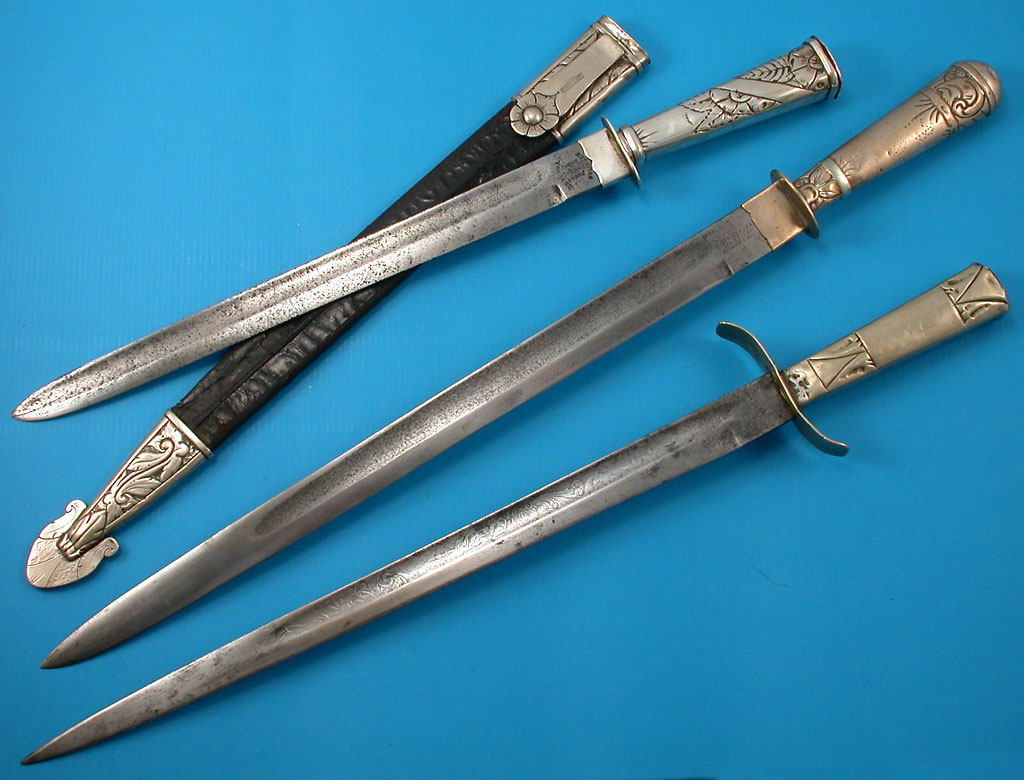 |
|
Photo
2. Three facones. The blades are single-edged with wide
fullers; two types of crossguards are shown: small and "S"
shaped. |
|
|
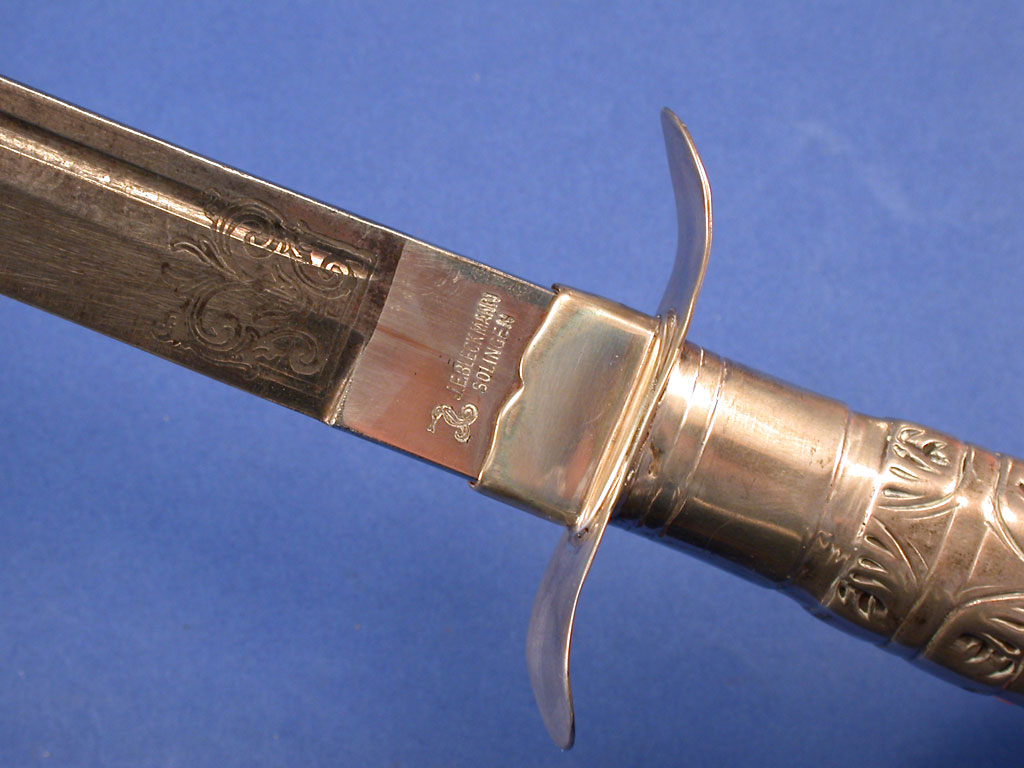 |
Photo 3.
Empatilladura. A reinforcement has been soldered to the
handle-crossguard assembly to strengthen the union of hilt to
blade.
Generally present in long-bladed facones and dagas. |
The blade of a typical facón
is very long and slim, single-edged, and sometimes with a short
double-edge near its point. The presence of a fuller is common
in these long blades. Facones also feature a double guard,
usually "S" shaped, though sometimes with the form
of an inverted "U", or a simple short crossguard. The
guards were intended to protect the hand of the bearer during
a fight, or to deflect an opponent's thrust.
|
Two Facones
and a Daga |
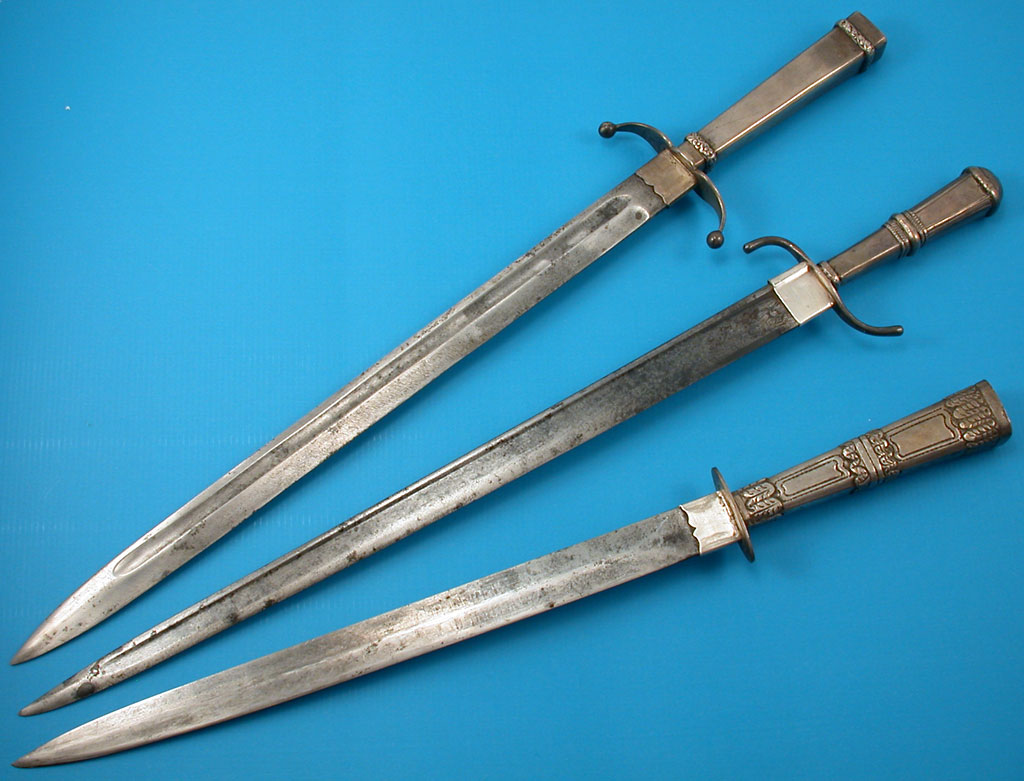 |
Photo 4. Top and
middle: Facones. Note "U" and "S"
shapes of crossguards.
Bottom: a daga (dagger) with short guard and typical double-edged
blade. |
An interesting sub-type was the
caronero which is a very long bladed facón
or dagger (single or double-edged) - almost a true sword - carried
between the caronas (a leather part of the gaucho saddle,
thus its name). Caroneros do not usually have guards as
they could get entangled with the saddle upon reaching for the
weapon. Contrary to the popular belief, caroneros were
not common or popular among gauchos. They were used by
lawless gauchos, militia members or soldiers and only
very occasionally by an ordinary gaucho.
|
Daggers |
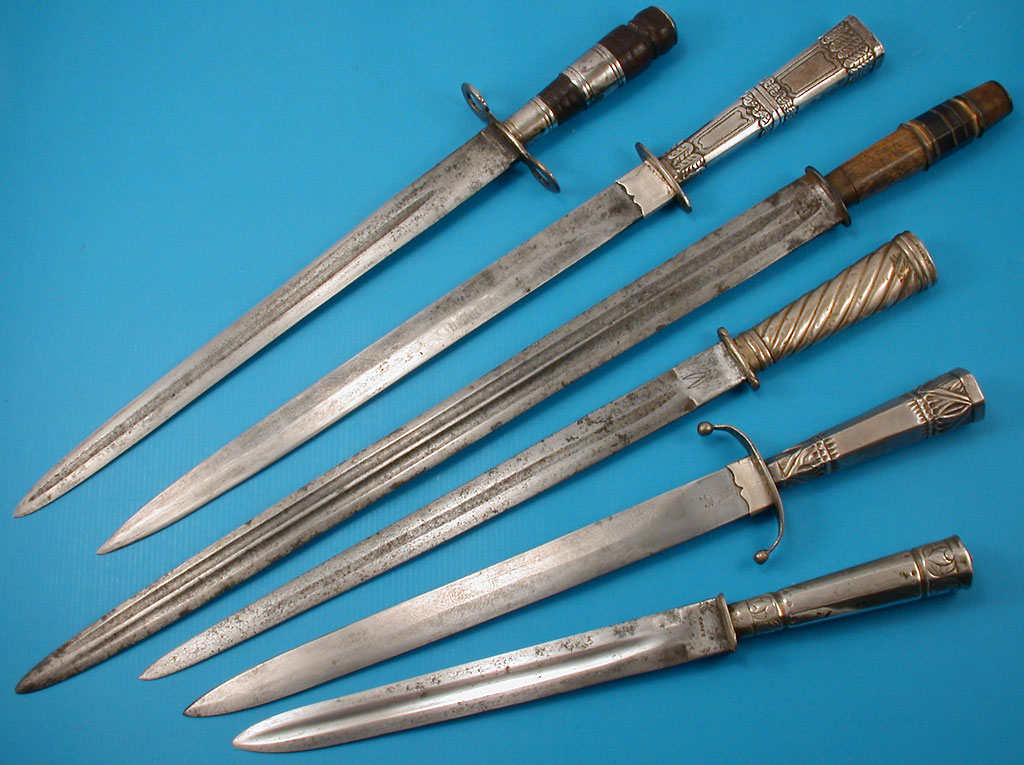 |
Photo 5. Daggers.
From top to bottom:
1) wooden handle with simple silver rings decoration and a double
guard with the figures of flamingo heads and necks.
2) dagger
3) interesting double-fullered blade, probably taken from an
old sword
4) blade with single central fuller and handle with typical fluted
design, a decorative form known as galloneado.
5) dagger with "U" shaped crossguard, and
6) dagger, blade with central fuller. |
The daga
(dagger) is similar to the facón in shape, but
the distinctive feature is that its long slim blade is double-edged.
|
Two Facones
and a Dagger |
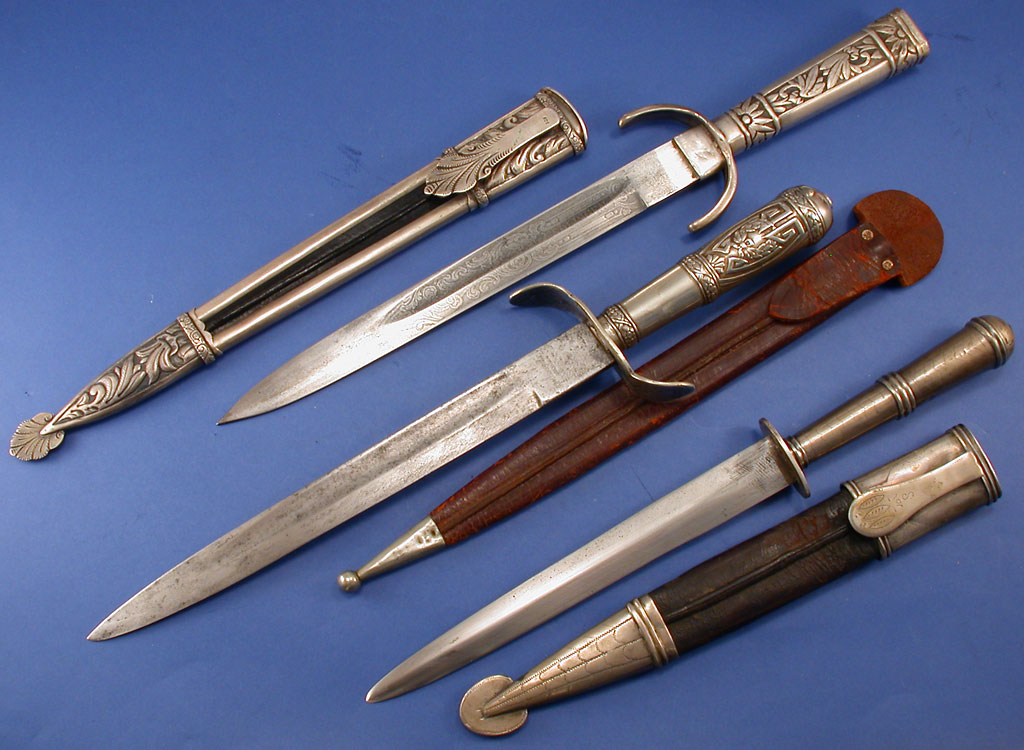 |
Photo 6. Top to
bottom:
1) Facón. "U" shaped crossguard. Note
the semi-circular throat of sheath to accommodate the curvature
of the guard.
2) Facón with "S" shaped crossguard.
3) Dagger with a double-edged blade, probably hand forged from
an old file.
This knife (3) was probably made by Indian silversmith, considering
the typically very simple and naive decoration motif. |
The cuchilla
is a utilitarian type of knife. Specifically, it is a big butcher's
knife with a curved edge and a straight back. It is interesting
to note that in the Spanish language there exist both the words
"cuchillo" (a masculine noun) and "cuchilla"
(a feminine noun). Gauchos seemed to find the image of
a "pregnant blade" in the curved edge or "belly"
of the cuchilla, according to the legend surrounding the
origin of the use of a feminine noun to name this type. The cuchilla
is a knife of full tang construction, with wooden slabs attached
to the tang by rivets and no bolsters. Cheap and easy to find
everywhere, cuchillas are one of the most popular types
of knife in use in the countryside in present times.
|
Cuchillas |
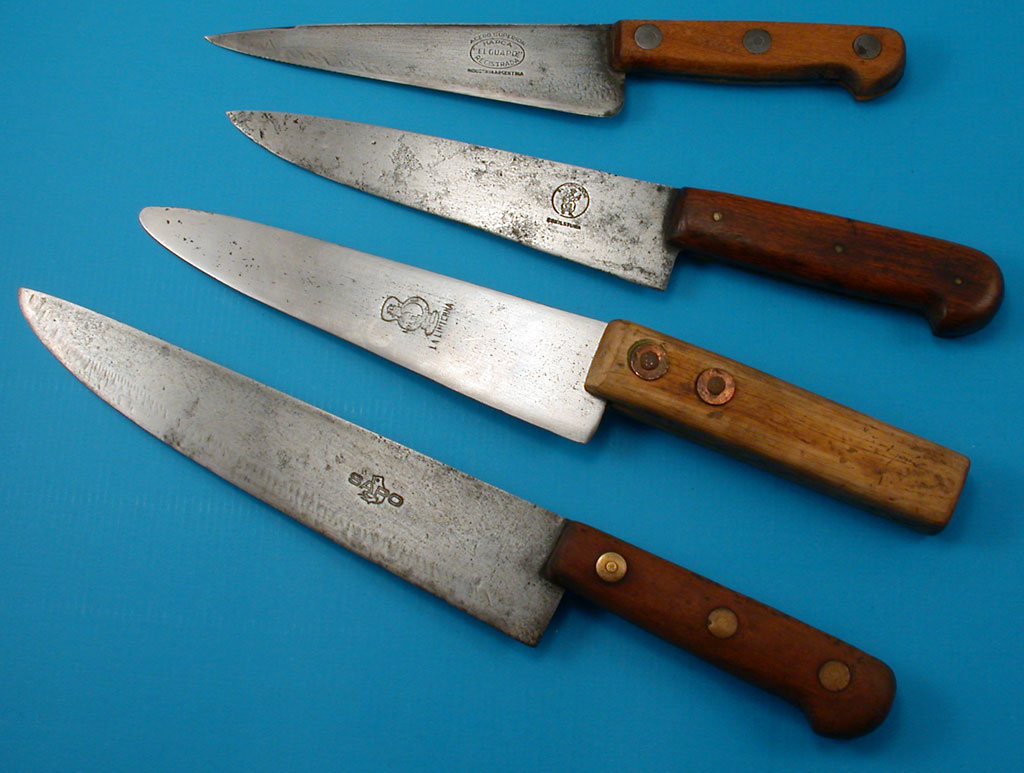 |
Photo 7. Group
of Cuchillas. Essentially common butcher knives with full-tang
construction, wooden slab grips and blades with a "belly"
shaped edge contour and straight back.
The "pregnancy" or fullness of steel felt in the "belly"
is reputed to have given the use of a feminine noun to name this
type. |
An interesting variant of this type
is what I call cuchillo de campo (country knife), which
was of later appearance, maybe during the end of the XIX century.
The cuchillo de campo is also of full tang construction
with a slab handle, attached by rivets, usually of wood or antler
and a false bolster made of brass or nickel silver. The shape
of the blade is slimmer and similar to that of the puñal.
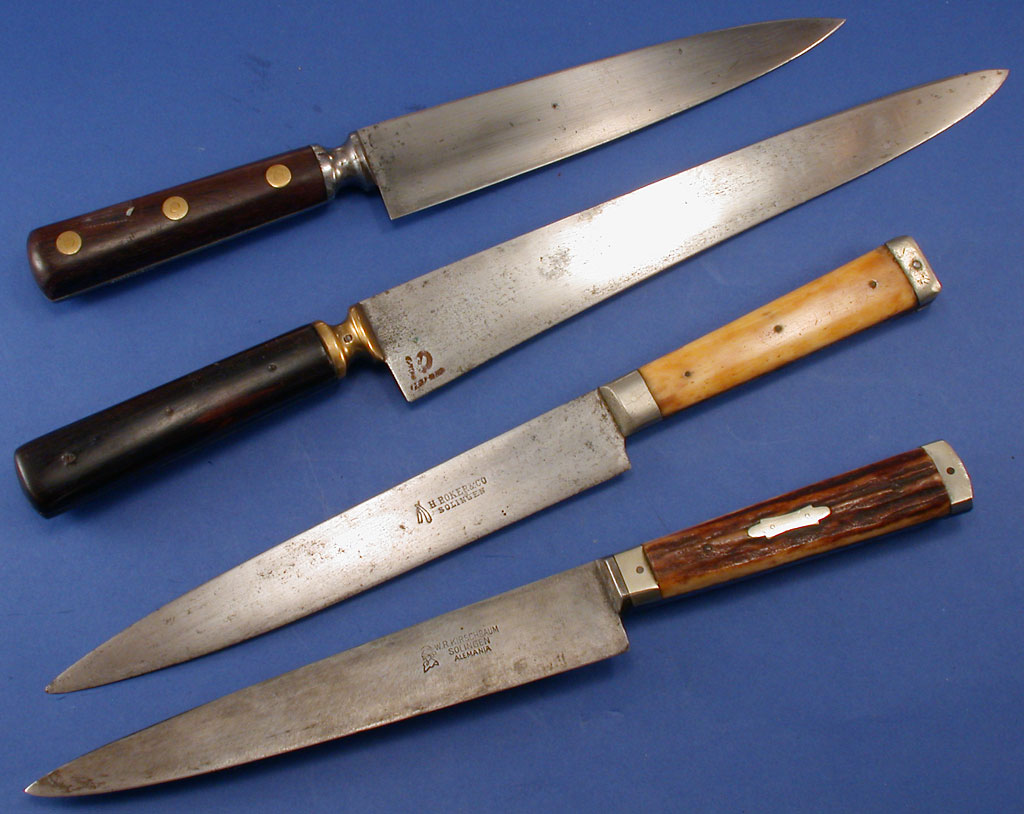 |
Photo 8. Cuchillos
de campo. Of more recent introduction, perhaps at the end
of XIX century; these types are more popular for use in town.
Interesting variations include examples of high quality construction,
like the two specimens shown at bottom of the above photograph
having white bone and stag handle slabs.
More common specimens, like the top two, are handled with wooden
slabs and have brass bolsters. |
|
|
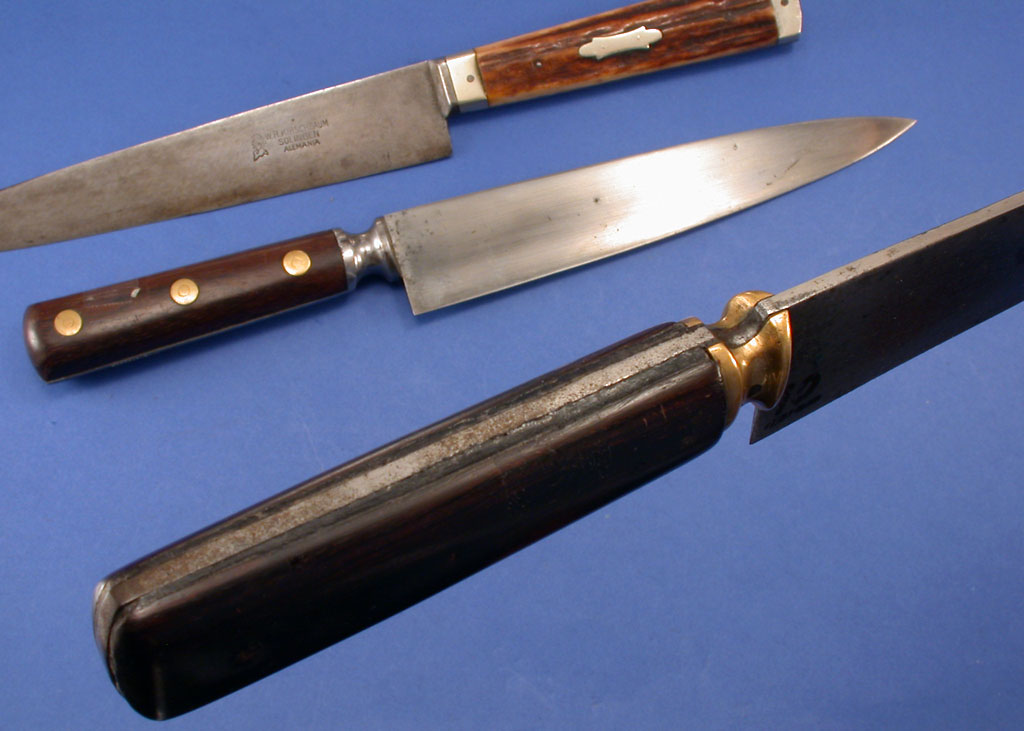 |
Photo 9. Detail
of typical construction of cuchillos de campo.
This type is closely related to cuchillas, being of full
tang construction, with grip slabs attached with rivets and false
bolsters made of brass or nickel silver.
The blade shape is similar to that of puñales.
Usually imported from Germany, but also from France and England. |
Puñal
As a knife collector whose personal
interests cover several different aspects of the fascinating
world of knives, the similarities between two most interesting
types of knives, Bowies and gaucho puñales,
have never ceased to amaze me. Although the historic, economic
and cultural milieu of North and South America followed different
roads, the significance of these knives in our respective histories
and cultures are of similarly great importance. In fact, the
saga of the conquest of the frontier, the conflict with the Indian
and the cattle industry are dominant factors in the development
of both of the two Americas. Both knives suffered the early menace
of restrictive laws trying to control their use. Both were principal
and sometimes the only weapons for their owners. But also, they
were multi-purpose tools in the hands of settlers, farmers, cowboys
and gauchos. In both cases, knives were used with outstanding
skill by our countrymen. There are also several features of South
American knives whose exact meaning or actual use are not clear
today; the same happens with certain characteristics of Bowie
knives.
Of the several types of gaucho
knives used in the past, I personally consider the most interesting
type to study (especially for Bowie collectors) to be the variant
known as the puñal, a knife which was widely used
along the territories of what today is Argentina, as well as
Uruguay and southern Brazil. This type features subtle distinctive
differences of design in each of these regions. Several years
ago I developed my own theory, tracing a common root in both
the Bowie knife and the puñal. I don't know if
this theory would be widely accepted among our leading Bowie
authorities in the USA and I can't say if I'll ever be able to
fully demonstrate its complete truth, but in the meantime I humbly
consider and present it to our readers as an approach to the
study of these most interesting types of knives - Bowies and
South American puñales- taking into account their
broad use during a large historical period of our countries.
The use of the name puñal
could be rather confusing for the historian, as the shape of
this knife can not be related to the classical European poignard.
Anyway, old European catalogs from the cutlery firms which supplied
this kind of blade to the South American trade call them puñales
or "daggers" in their literature. It is also interesting
to point out that in local common day language -e.g. in a newspaper
crime news- it is usually referred as a puñalada,
for "stabbing." So also is the verb used to name the
act of receiving a wound with an edged weapon, no matter the
actual shape or type of knife used in the stabbing. It is very
common among Argentine military personnel to call any type of
fighting or military knife puñal without paying
attention to its actual shape or design. This may somewhat explain
the wide use of the word puñal among common people,
referring to any kind of knife.
Originally blades for puñales
were forged in Germany, Belgium, France and England but the exact
story of the origin of the puñal remains a mystery,
as does who designed its distinctive blade shape and when it
actually first appeared - perhaps in the XVIII century or earlier.
The Spanish influence upon these
knives is evident as soon as you compare their shape with the
Belduque, Albacete and Flandes knives brought by the Spaniards
to our lands. On the other hand, there is a Germanic influence
too, as there were several types of knives of German origin which
used the same blade shape long before the gaucho knife.
The so-called "Mediterranean
Dagger" (actually a single-edge knife) is a knife which
was used in Spain, Italy and France during the XVII and XVIII
centuries and it is commonly shown as a probable origin of the
early Bowie knives and is also probably connected to certain
Genovese and Corsican fixed blade knives. As a matter of fact,
we know that Mississippi, Louisiana and Texas received a very
strong French and Spanish influence in those days and some early
Bowies elicit a strong reminiscence of the European dagger or
knife. This can be easily seen for example, in the classic lines
of the knife Searles made for Rezin Bowie.
Both South American puñales
and early Bowies and Spanish Mediterranean daggers can be compared
with large butcher knives and actually this was the way Bowie
knives were described in early documents and newspaper accounts
of knife fights.
|
Puñal
Criollo |
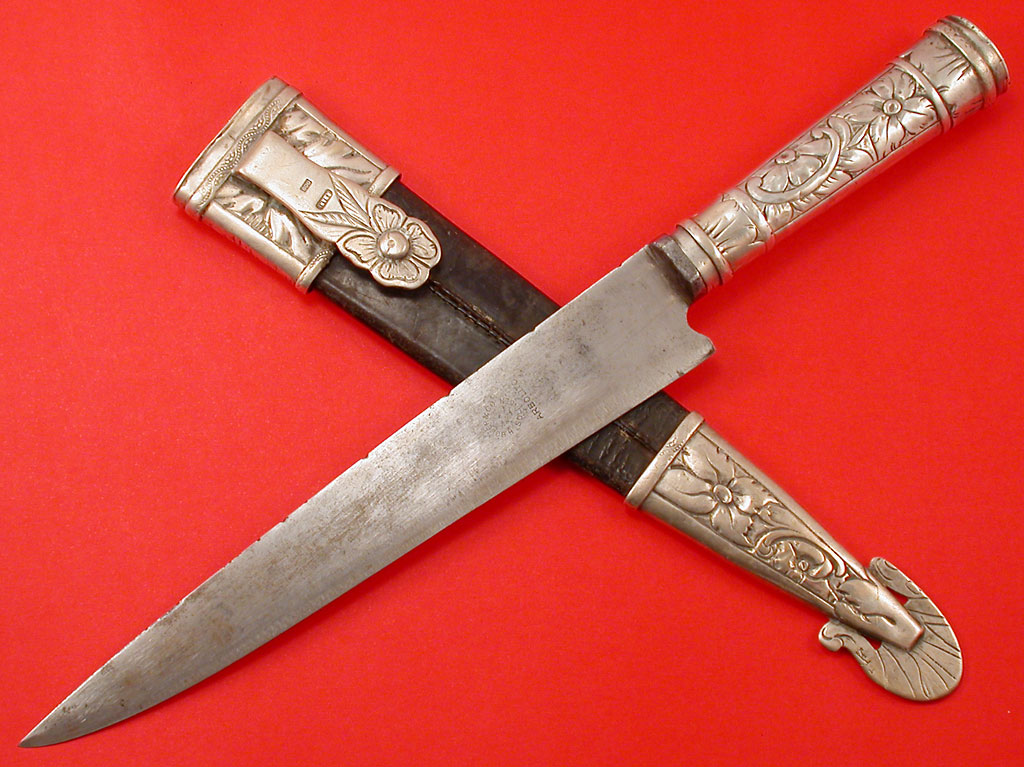 |
|
Photo 10. Puñal.
Blade length 27 cm (11 inches) with square bolster denoting Argentinean
origin of this Boker/Arbolito German blade. |
I'd like to call the attention of
our readers to several main characteristics of gaucho
puñales: the slim, elegant spear pointed blade,
the presence of an integrally forged bolster or "button"
(in Spanish, botón) which reinforces and divides
the blade from its tang, the use of "cuts" or file
marks on the back of the blade and the presence of some kind
of "notch" in the ricasso of the blade.
|
Integrally
Forged Bolster (Botón) and Form of the Tang |
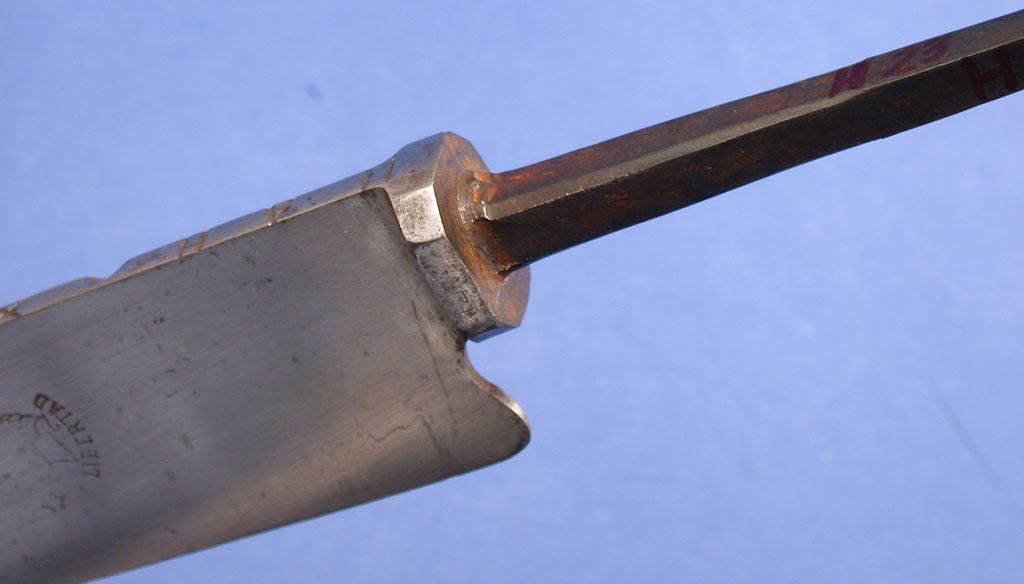 |
Photo 11. Detail
of a never-used puñal blade, with square bolster,
prepared for use in the Argentine market.
Commercial brand Libertad, imported from France by Anezin Hermanos,
an importer of Buenos Aires. (circa first quarter of XX century) |
|
|
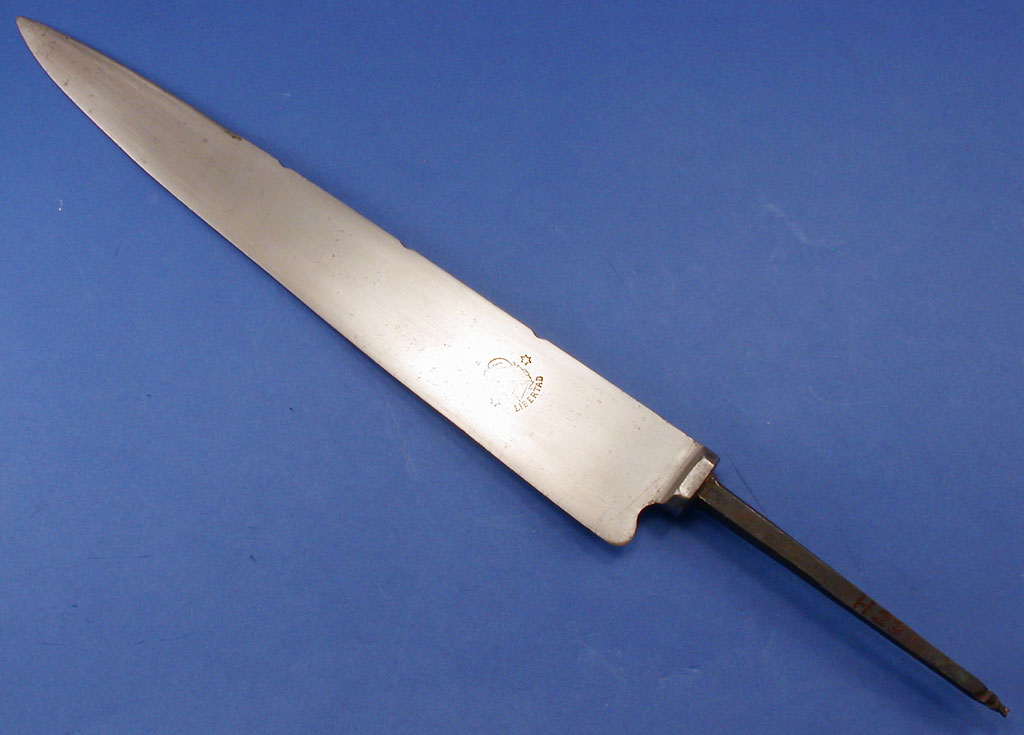 |
|
Photo 12. Same
blade, 27 cm length |
These blades have a "rat tail"
tang, which remains enclosed within the handle of the knife.
The bolster (we call this integrally forged bolster botón,
meaning "button") which also appears in several early
American Bowie knives and naval dirks as well as in European
types, had a rounded shape in Uruguayan and Southern Brazilian
knives, while in those used in the present day Argentine territories
had distinctive square-shape sides. There is no known explanation
regarding these differently shaped bolsters and their geographical
distribution, except that the rounded bolster ("button")
seems to be of earlier appearance. Because of the use of a bolster,
puñales never have any type of guard or crossguard.
|
Rounded
"Buttons" |
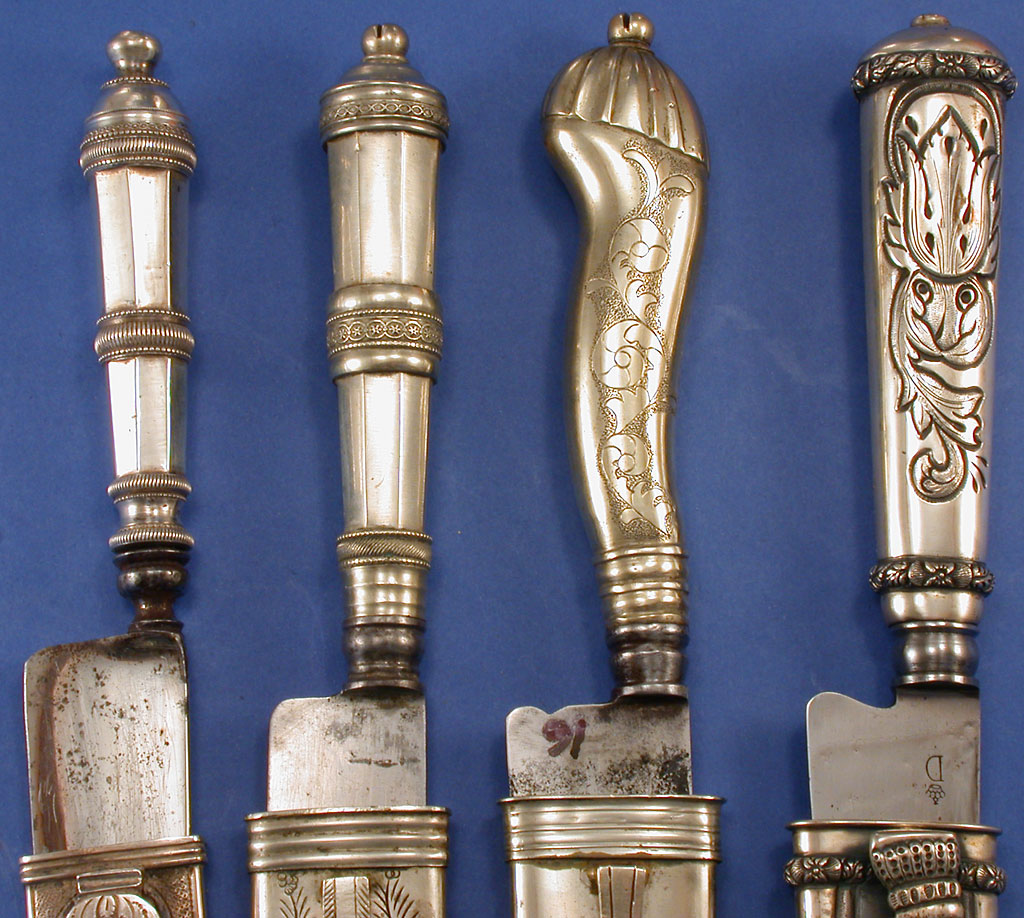 |
Photo 13. Detail
of circular bolsters or round "buttons" (botón
Redondo o botón oriental). Left to right:
1) Brazilian knife. Blade marked with maker's name and also Rio
de Janeiro. Probably end of XVIII century. Made for the southern
Brazil market.
2) Knife, probably made in Germany, for South American use (circa
beginnings XIX century). No makers markings.
3) Probably German, circa beginnings XIX century. No maker's
markings. Notice round bolster feature and Spanish notch
4) Knife of present day making by local silversmith Carlos Canali,
following the style and patterns of old knives of the XIX century.
The blade is an antique one, probably from the end of the XIX
century or the beginning of the XX century, of Belgian origin
with markings of a famous and now closed gun shop of Buenos Aires. |
|
|
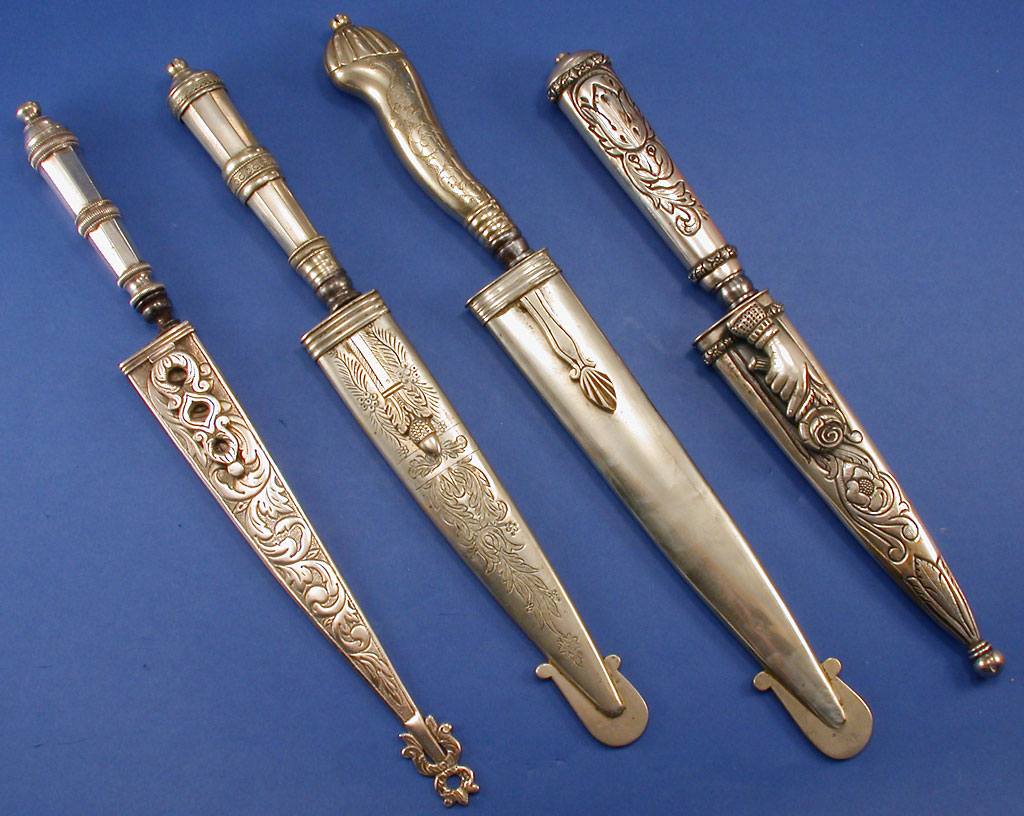 |
|
Photo 14. Same
knives described above, full length and in sheaths. |
|
|
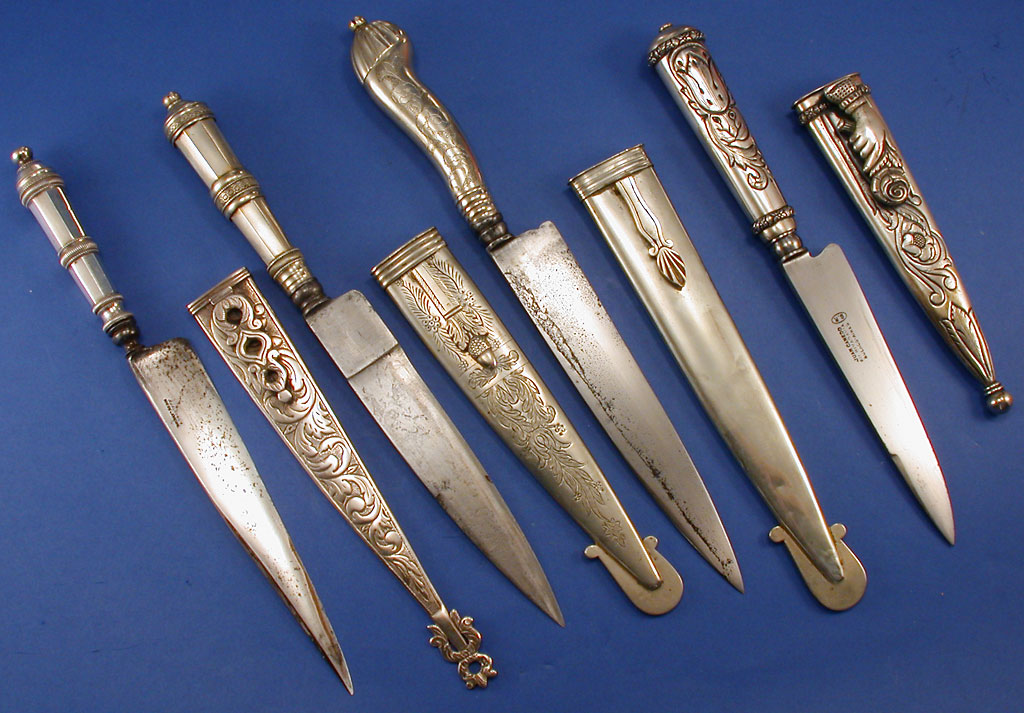 |
|
Photo 15. Same
knives described above, full length. |
|
Typical
Uruguayan and Brazilian "buttons" and sheaths provided
with a "button keeper" |
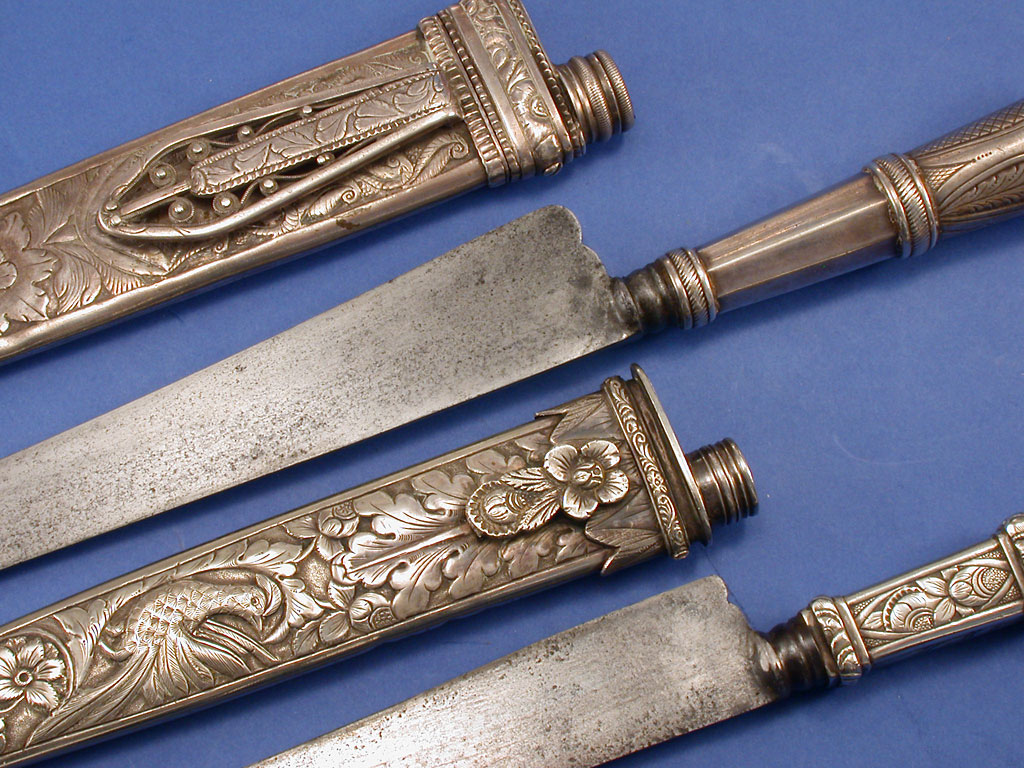 |
Photo 16. Top:
Puñal for Rio Grande (southern Brazil) market.
Blade markings of the well known brand cocoteiro (palm
tree), of Belgian origin.
Below: Knife for the Uruguayan market. Blade of famous brand
Sol (sun) and Broqua & Scholberg, of Belgian origin.
Notice the Spanish notch on the ricasso (base) of each blade
and also note the semicircular extension from the sheath mouth
which covers and protects the blade's bolster while the knife
is inside the sheath, a feature usually associated with Brazilian
and Uruguayan sheaths. |
|
|
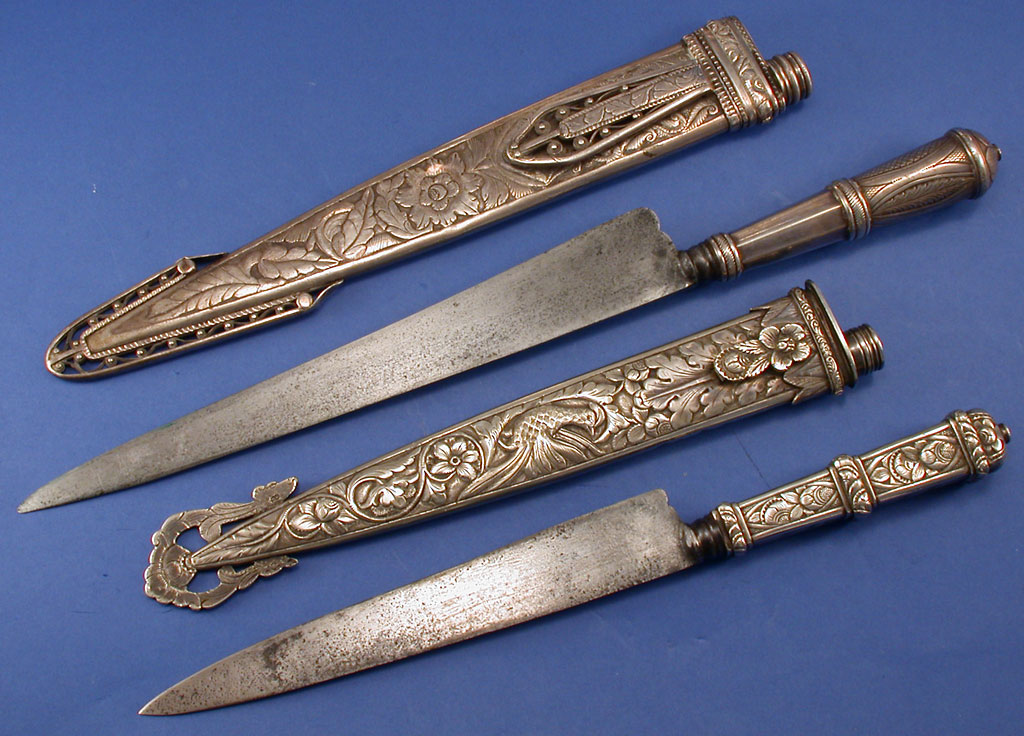 |
|
Photo 17. Same
knives described above, shown full length. |
|
Squared
"Buttons" |
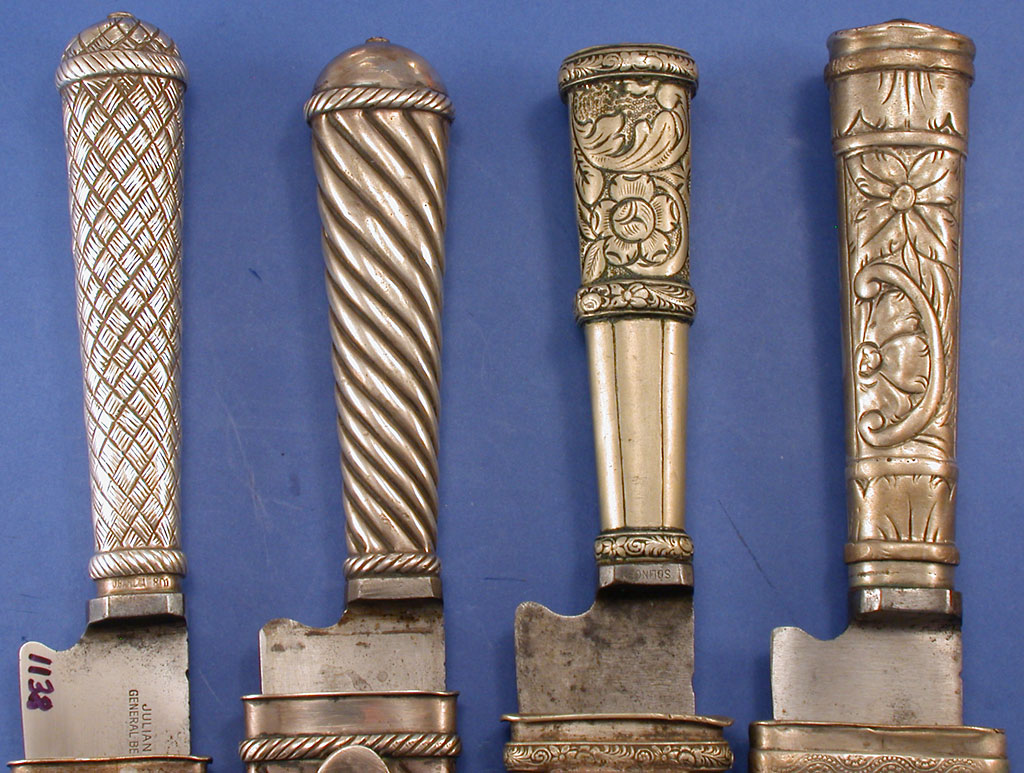 |
|
Photo 18. Four
Argentine puñales, mounted in silver, showing their
square bolsters or botón cuadrado (rectangular
in overall cross section, but with facets replacing what would
have been sharp edges, so actually octagonal). Notice also the
semicircular notch on the ricasso, used to rest the index finger
and prevent the hand from slipping towards the edge when stabbing. |
|
|
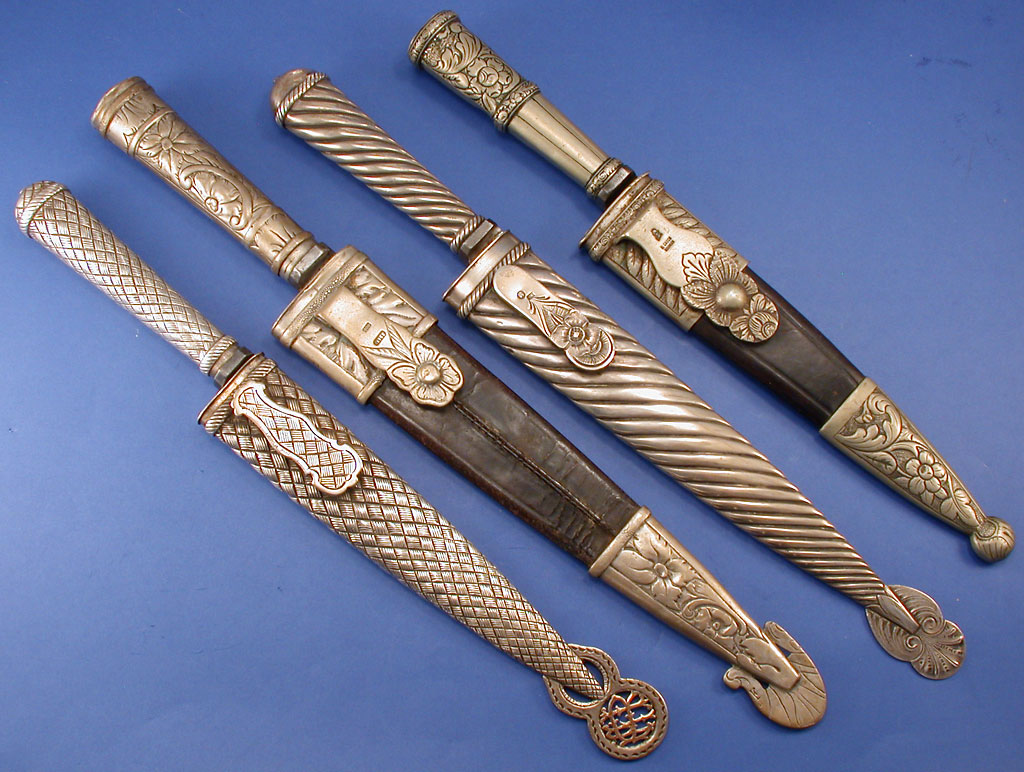 |
|
Photo 19. Same
knives of previous picture. Sheaths completely made of silver
or leather with throat and tip of silver. |
|
Trade
Marks |
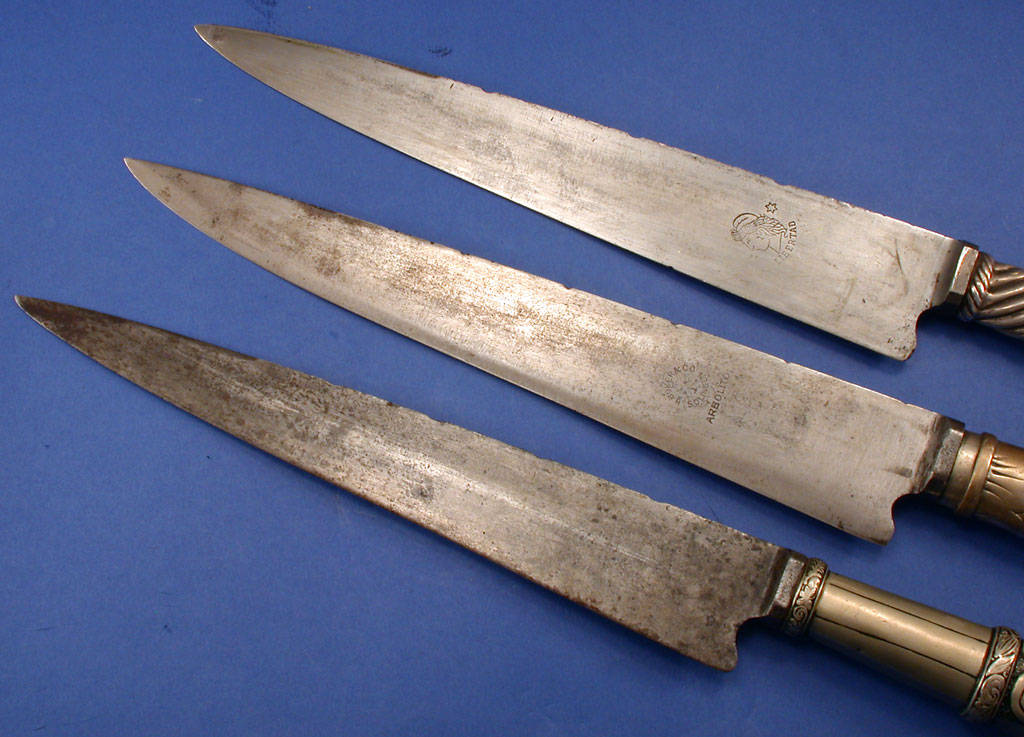 |
|
Photo 20. Detail
of the blades of these same knives. |
Regarding the use of the file marks
on the back of blades of puñales there are several
explanations; one such explanation assures that they were used
as "cattle counters" (each mark counting as a bead
in an "abacus"), another that they served as wire cutters
and yet another that they were an edge-destroying device for
the opponent's blade edge during a fight. Although I feel that
those marks could have been incidentally used as described, I
personally believe that these were just cosmetic decorations,
which were also present in Bowies, as well as in Spanish navajas
(clasp folding knives). (By the way, in Spanish navajas
we can usually find other "Bowie like" features: clip
point blades and the widespread custom of decorating them with
phrases and mottoes. Just a coincidence or the transfer of customs
from the Spanish-French immigration to the Southern U.S. Territories
of the XIX century?)
|
File
marks |
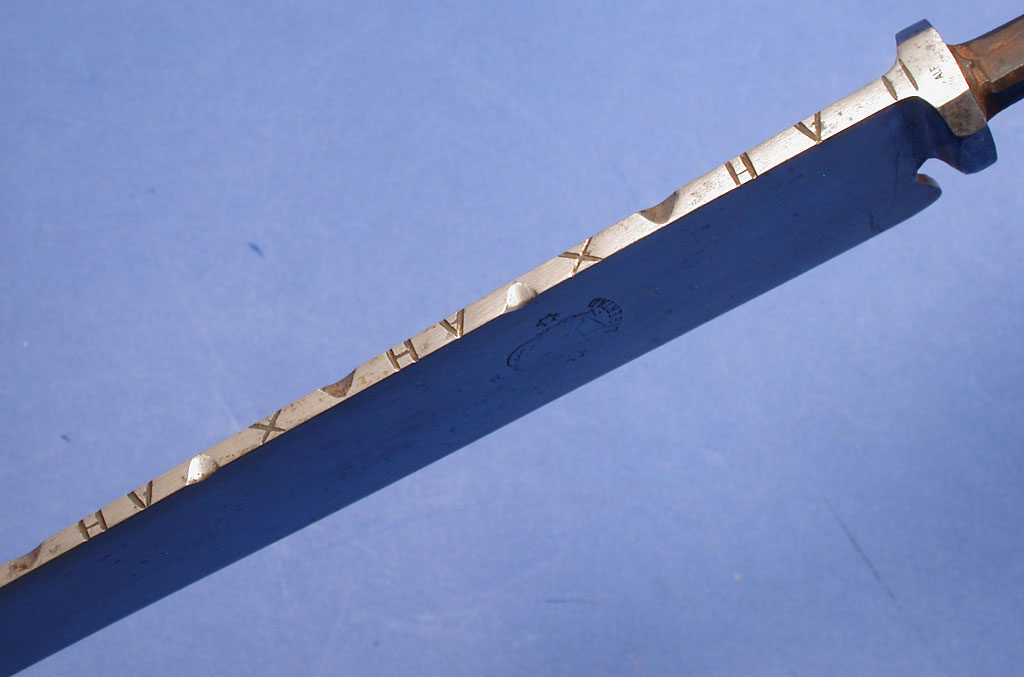 |
Photo 20. Usual
notches or file marks on top of the back of blade. Typical on
most Argentinean puñales with each brand having
their own pattern of marks.
Popular beliefs attribute different uses to these file marks,
but in my personal opinion, they were just decorations. |
Much has been written regarding
the true purpose of the so-called "Spanish notch."
As a matter of fact, on page 7 of ABKA Newsletter # 4
there is an interesting paragraph about Mr. Sterling Wortham's
tracing of an old "Toledo" marked Spanish scissors
and a discussion about the possible use of its "notches"
when working with twine. Another interesting discussion on this
issue was written by the late noted collector and writer Mr.
William Williamson on the occasion of the publishing of a special
work for the famous Exhibition of La Commission des Avoyelles
(Bowie Knives/Origin & Development, October 1979 -
pages 24 & 25). The two Spanish daggers shown on page 25
of that work show several features usually associated with gaucho
puñales, including round bolsters and half-moon cuts
on the ricasso, confirming the common roots of Bowies and gaucho
knives. I have often asked myself if we can really link the purpose
of those notches with the menacing rompe puntas (point
breakers) of those Spanish left hand (main gauche) daggers used
in the past, as has often been suggested; I really doubt it.
It is possible that its intended use was that of catching the
opponent's blade, but the shape of the notch present in some
Bowies suggests another use to me. For example, the knife pictured
in the book Bowie Knives by Robert Abels (The Ohio Hist.
Scty, 1962), under number 3-K1A3c 10 1/2, depicts a corresponding
hole in the sheath. This feature suggests an intended use to
secure the knife to its scabbard by means of a leather thong.
The notch in a well known Samuel Bell knife could have accommodated
some quick release retention device, like a small short chain
with a ring secured to the belt.
Truly, it is a thrilling view that
we get when we think about a duel occurring in those far gone
days, during which the duelists try to break or catch the other's
knife blade. But I think that
we have to remember that the fighting methods of our ancestors
were more dictated by their natural instincts, survival desire
and personal skill than by formally educated and learned esgrima
technique, like that of the different European swordsmanship
schools. Thus, it is my personal
belief that the presence of the "Spanish notch" responds
to a less romantic or thrilling reason: it was more a cosmetic
touch of the artisan who made the piece, reminiscent maybe of
those European knives he might have seen, than a feature intended
to be used in parrying techniques.
I also wish to point out that the
ricasso of most puñales shows a "half-moon
cut" whose use, it is generally accepted locally, was for
the placement of the index finger when grasping the knife. This
half-moon cut is especially useful when the owner intends to
make a thrust with his knife, by preventing his hand from slipping
onto the blade and cutting the fingers. Do our readers remember
the story of Rezin cutting his fingers in the calf episode? The
primitive knife Rezin was using on that occasion didn't have
a guard and when Rezin Bowie stabbed a calf to kill it, his hand
slipped onto the blade edge producing a severe wound. It is said
that this accident led to the use of a guard in the knives subsequently
ordered by Rezin. Gauchos used to place their index finger in that
cut whether using their knives as cutting tools or as weapons.
The finger inside the "half-moon notch" prevented the
forward movement of the hand towards the blade edge and it also
allows better control of the knife. (The blade notch on a Samuel
Bell knife pictured on page 25 of The Antique Bowie Knife
Book shows exactly the same shape of the ones present in
several gaucho puñales).
As I said before, the blades for
South American puñales came from Europe. Some of
the most well regarded brands were "Arbolito" (Boker),
"Defensa" (Weyesberg) and "Herder" from Germany;
"Dufour" from France and "Joseph Rodgers &
Sons" from England (By the way, we all know that Joseph
Rodgers produced very high quality cutlery, including Bowies!!)
The list of blade brands used in the
making of gaucho puñales is very long and it is
never complete. Local importers ordered blades from German cutlery
firms and requested the stamping of special markings, usually
in Spanish, and/or with prominent figures of related objects
or animals well known in the South American region: a mate
(small gourd or pumpkin used as a vessel to contain the typical
local hot beverage sipped with a metallic straw), a running ostrich,
a sheep, the sun, a hunter firing his gun, a bull, a stirrup,
a tree, etc., etc... Generally, local consumers of knives of
those bygone times were incapable of reading or writing, so they
needed the logo on the blade to recognize their favorite brand.
Use of
the Knife and the Gaucho Duel
Together with his horse, the knife,
especially the facón or daga, was the distinctive
tool/weapon of the gaucho, to the point of not himself
existing without them. Gauchos were famous for the skillful
use of knives and the use and abuse made of edged weapons during
their duels. To understand this, we should bear in mind their
background and epoch: these were solitary men. Very tough men
raised in total solitude, almost without parental guidance. With
no education, almost no religion, they spent their lives in the
middle of the large plains in constant touch with nature, the
danger of wild animals and Indians, the constant peril. They
often spent long periods of time in solitude without seeing another
human being and their only source of distraction or satisfying
their very few extra needs was to reach one of the hundreds of
pulperias distributed along the frontier. Pulperias
were a special kind of country store, poorly built with adobe
walls and a thatched roof. The owner of the pulperia provided
the few gaucho needs: tobacco and paper for making cigarettes,
yerba to prepare the national infusion called mate
and some pieces of clothing, among a very few other things. Gauchos
paid with silver coins obtained in their part time jobs or by
smuggling or earned by playing cards, or simply paid for those
goods with exchange of cow hides, ostrich plumes and other products
of animals they had hunted. Pulperias also provided the
unique possibility of social distractions, joining other gauchos
to drink, to play cards and to talk, or just to play guitar and
dance. They also provided the unique opportunity of seeing a
woman for the first time in several months and the oldest profession
in the world was one of the main attractions of those places.
Gauchos liked drinking and high alcohol content beverages
were their favorite ones. Now, the meeting in the same small
place of several tough men, heavy drinking and very few and rarely
seen women was a very explosive formula indeed!
Any gesture, under this delicate
atmosphere, could ignite a dispute and give rise to a duel. A
contradiction during conversation, the misunderstood use of a
word, an erroneous comment about a woman present in the pulperia,
or just about anything pronounced after having finished a couple
of bottles of alcohol could be the invitation to prove who was
better with the knife, or who was more rude or brave. Sometimes,
a person had the reputation of being the best knife of the region,
and this was reason enough for to provoke the challenge of another
gaucho. Once the duel was inevitable, the men went outside
the building to prove themselves, knife in one hand and their
poncho rolled on the other arm to protect the body as a shield,
a technique inherited from the Spaniards, who used their capes
in the same way.
The intention was far from killing
the opponent. They just wanted to mark the other, especially
on the face. That mark would tell to everybody and forever that
the bearer of the scar had lost a duel. But sometimes in the
heat of the moment, the excess of alcohol and the rage generated
in the fight ended in a fatal wound. One of the gauchos
died and this was considered an accident, a disgrace, an unwanted
death. The killer was seen with sympathy and was often helped
by the onlookers, who considered him as a man in disgrace who
was in need of protection and help in escaping from the Law.
He often fled to the plains, sometimes getting a home for some
time in the nearby Indian villages where he waited till his crime
was forgotten or authorities changed. Or, he took this as an
opportunity to travel to a far town. Only those gauchos
who were known deliberate killers were seen with little sympathy
and persecuted by the Law with more care. These were called gauchos
matreros, always changing of place, always persecuted.
Another brutal practice of the time
was mercy killing to end the pain of a suffering friend or familiar
who had a disease or a severe injury producing great suffering,
far from the possibility of a doctor's help or medicines. To
put an end to their misery was known as to make the Holy work,
that is, to kill the suffering person with a quick pass of the
knife through the throat, something which was seen with permissive
eyes by common people. This is something which has to be understood
within the ethic, moral, social and cultural background of the
epoch.
We should bear in mind what a foreign
traveler - surprised to know the intensive use of knives by gauchos
- said: "Gauchos use their knives the same, to open a cow
or to close a discussion." Estadist, writer and former
Argentine President Domingo F. Sarmiento wrote in his book Facundo
published during the XIX century: "The gaucho is
armed with the knife he inherited from the Spaniards & more
than a weapon, the knife is an instrument which serves him in
all his tasks; he can't live without his knife; it is like the
elephant trunk, his arm, his hand, his finger, his everything."
The common contemporary vision suggests
that gauchos passed half of their lives riding horses,
hunting wild cattle just to take their hides and eat their tongues
and a little of the meat, and the other half fighting duels.
This is due to the old tales and descriptions written by foreign
and local travelers visiting the pampas during the XIX
century and giving details of the duels they have witnessed and
the horrible scars on the faces of the gauchos they have
met. The truth is that some
gauchos had dueled sometimes, but not so often as we usually
think. Knives were indeed used heavily, but mostly as tools,
throughout the gaucho's long days in the prairie, in hundreds
of small and large tasks. The knife was an essential extension
of their hands: the single utensil required for eating, both
as cutting implement and fork; necessary in the task of cutting
small wood for making the cooking fire; necessary in cutting
strands of tobacco; necessary for slaughter and skinning of cattle
and cutting their meat as well as in cutting hay to make the
roofs of their poor houses and making adobe bricks for the walls;
necessary in cutting hides to make or repair their saddles, headstalls,
reins, and lariats - leather was used in hundreds of things.
I feel and always try to put emphasis in the fact that knives
were tools, often the only tool gauchos had, and that
they used them as such and just on occasion in a fight with another
gaucho. This in spite of the popular image of dueling gauchos,
driven by literature and the common conception of present-day
people.
Ways of
carrying a knife
The appearance of the metallic cartridge
and the perfection of repeating guns marked the beginning of
the decline of the use of Bowies. It is interesting to note that
while in the North American territory firearms rapidly took the
place of these fascinating knives, the opposite happened in South
America, where the knife kept its place as the main personal
weapon until the first quarter of the present century. Customarily,
gauchos carried their long bladed knives across their
lower backs, crossed through their tirador (wide belt)
and with the edge upwards. This enabled them to carry a very
long blade easily, especially when riding a horse, and also to
unsheathe it very quickly and ready to cut. In his books published
during the XIX Century, English traveler and author Cunninghame
Graham wrote that these knives crossed on the gauchos'
backs looked like the Latin sail of Mediterranean boats. (Note:
tirador is the name of a heavy and wide
leather belt, closed in the front with a distinctive and big
silver buckle called rastra. The belt also carried important
personal papers and money, like the cowboy "moneybelt",
and was usually decorated with silver or gold coins.) Smaller
knives, with blades of not more than 13 or 15 cm and with metal
or wooden handles, a smaller version of puñales,
are usually carried on the front and are called verijeros.
This name of verijero comes from the carry position, on
the front near the right side of the belt buckle (rastra)
and near the groins, a part of the body popularly known locally
as verijas. Argentineans remain fond of owning a little
verijero, silver handled, sometimes with silver sheath,
and making it proudly shine at a Sunday barbecue (asado).
Its 13 to 15 cm blade makes a very practical cutting tool indeed.
It is also interesting to remark
that, while we won't see a "Peacemaker" hanging on
the belt of a present day working cowboy, you will surely find
a knife (usually a short bladed puñal) crossed
on the back or a small verijero on the front of almost
all modern gauchos while working in the range today.
Of course, present day countrymen ride
both horses and modern pick-ups and to ride a truck with a knife
crossed on the back is very uncomfortable, so the knife comes
to be carried inside the glove box or under the cab seat. Also,
to bear a large knife openly while walking in a town street is
seen as politically incorrect by present customs. In some small
countryside towns nobody cares if someone is wearing working
clothes and is carrying a criollo knife on his belt. By
the same token, and as previously said, all men working in the
country wear a fixed blade knife of small proportions as a practical
tool. I have often seen larger knives (puñales)
still carried on the back in the usual tradition by country workers
inside the boundaries of estancias and while riding their
horses. Of course, facones and dagas are of little
practical use for work and are today only seen in desfiles
(parades) during festivities and celebrations, worn by typically
costumed men.
In any case, knives remain very
popular among Argentineans and in spite of the fact that very
few know the true origins and meaning of gauchos, most
still associate the word facón with their figure and personality. And
creole knives continue to be a symbol of the past, closely related
with those fierce, valiant, tough men, proud of their freedom,
and remain also as symbol and reminder of more romantic, adventurous
and dangerous times.
Abel A. Domenech
dagasdeplata@yahoo.com
Bibliography
- ABKA Newsletter # 4 - page
7
- Bowie Knives/Origin & Development - by William Williamson
- La Commission des Avoyelles/October 1979.
- The Antique Bowie Knife Book - B. Adams/J.B. Voyles/T.
Moss/ Museum Publications, 1990.
- Sale of J. Rodgers Exhibition Knives - catalog by Jim Parker,
1988.
- Dagas
de Plata - Abel A. Domenech Buenos Aires, 2006.
Copyright © 2008 by Abel Domenech
Gratitude is due to Abel A. Domenech for sharing his great expertise
of these traditional South American knives; much more detail
and an abundance of illustrations drawing from his lifelong study
of these knives is available in his 2006 Spanish language book,
Dagas
de Plata.
Gratitude is also due to forum member Gonzalo G. for arranging
for the publication of this essay.




















